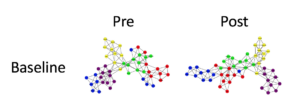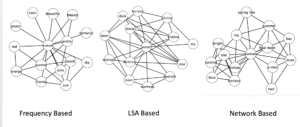
The role of knowledge in high-level cognition
We apply computational, behavioral, and neural methods to study the role of knowledge in high-level cognition, focusing on creative thinking, associative thinking, and memory search and retrieval. Such research includes applying computational methods from network science to represent the semantic memory structure of individuals and groups, and examine how their memory structure, and the dynamic processes that operate in this system, relates to individual differences in high-level cognition. Similarly, at the neural level, we examine the neural structure and dynamics that relate to knowledge and their role in generating high-level cognition. This work, for example, empirically verified the classic associative theory of creativity, that posits that higher-creative individuals have a more connected, “flexible” semantic memory structure than lower-creative individuals.
 The dynamics of semantic memory
The dynamics of semantic memory
We apply converging empirical methods to investigate how semantic memory changes with regard to individual differences and context. Specifically, we study the ‘aging lexicon’, and how people’s memory change as they age; how we can measure the effect of learning on semantic memory structure; and how interfering with neural processes alters ones’ ability to retrieve from their semantic memory. This work has, for example, demonstrated how and in what way we can measure the effect of different strategies in combining concepts on the semantic memory structure of those concepts.

Cognitive network science
Our work develops and advances the field of Cognitive Network Science – the application of computational tools from network science to study cognition. We do so by developing and adapting relevant methods from other fields to study various cognitive phenomena; investigating the significance of network science methods in objectively studying abstract cognitive constructs; and by developing and promoting straight-forward analysis pipelines to minimize barriers and enhance accessibility of this approach to the wide Cognitive Science community. This work has, for example, developed a semantic network based measure of semantic distance, developed an objective measure of flexibility of thought, and related cognitive network methodology to traditional dimensionality reduction approaches.

Clinical cognitive networks
We apply similar approaches to study atypical memory structure in clinical populations. Such work uniquely addresses the cognitive level, complementing additional approaches that study the neural levels of clinical populations (e.g., computational psychiatry). Our work has examined the semantic memory structure in children with cochlear implants, people with high functioning autism (Aspergers’ syndrome) and people with schizophrenia. This line of work aims to examine how quantitative measures of semantic memory structure in clinical populations can be used in diagnostic and intervention settings.